商务英语翻译 第七章 被动语态翻译
- 格式:ppt
- 大小:147.50 KB
- 文档页数:26
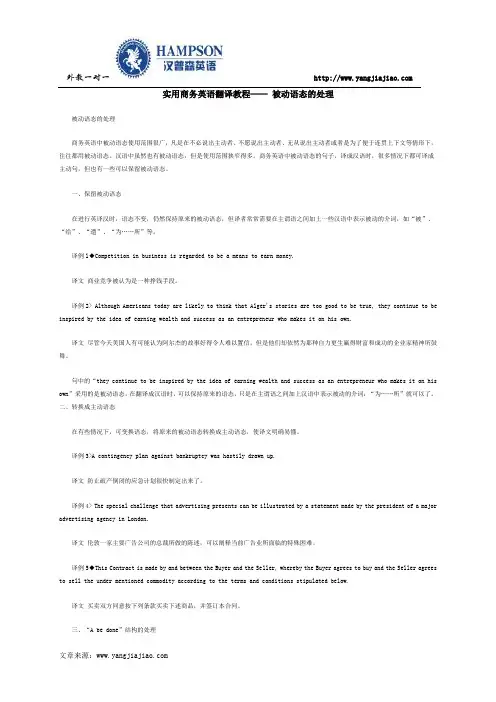
外教一对一实用商务英语翻译教程——被动语态的处理被动语态的处理商务英语中被动语态使用范围很广,凡是在不必说出主动者、不愿说出主动者、无从说出主动者或者是为了便于连贯上下文等情形下,往往都用被动语态。
汉语中虽然也有被动语态,但是使用范围狭窄得多。
商务英语中被动语态的句子,译成汉语时,很多情况下都可译成主动句,但也有一些可以保留被动语态。
一、保留被动语态在进行英译汉时,语态不变,仍然保持原来的被动语态,但译者常常需要在主谓语之间加上一些汉语中表示被动的介词,如“被”、“给”、“遭”、“为……所”等。
译例l◆Competition in business is regarded to be a means to earn money.译文商业竞争被认为是一种挣钱手段。
译例2> Although Americans today are likely to think that Alger's stories are too good to be true, they continue to be inspired by the idea of earning wealth and success as an entrepreneur who makes it on his own.译文尽管今天美国人有可能认为阿尔杰的故事好得令人难以置信,但是他们却依然为那种自力更生赢得财富和成功的企业家精神所鼓舞。
句中的“they continue to be inspired by the idea of earning wealth a nd success as an entrepreneur who makes it on his own”采用的是被动语态,在翻译成汉语时,可以保持原来的语态,只是在主谓语之间加上汉语中表示被动的介词:“为……所”就可以了。
二、转换成主动语态在有些情况下,可变换语态,将原来的被动语态转换成主动语态,使译文明确易懂。
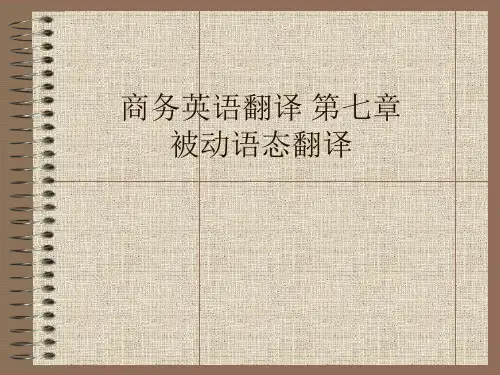
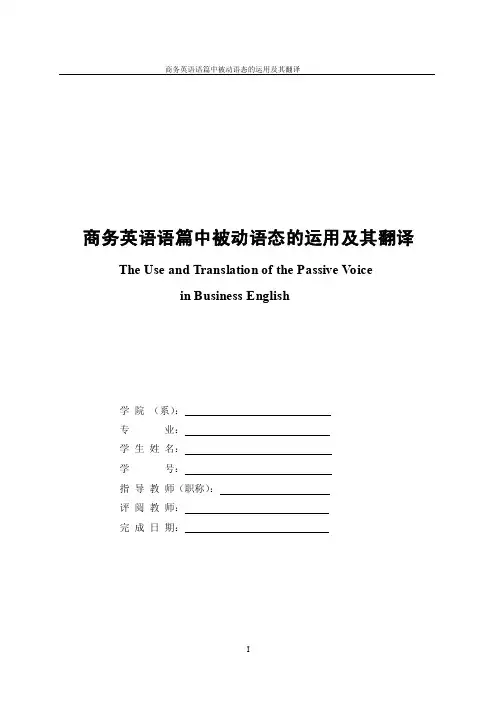
商务英语语篇中被动语态的运用及其翻译The Use and Translation of the Passive Voicein Business English学院(系):专业:学生姓名:学号:指导教师(职称):评阅教师:完成日期:I商务英语语篇中被动语态的运用及其翻译[摘要]被动语态是语言学中较为常见的语法现象。
较汉语而言,英文中使用得更为广泛,尤其是在商务英语这一实用性语体中更是有着举足轻重的地位。
本文共分四章对此课题进行研究,首先对英汉语篇中被动语态做对比分析;接着进一步探究了商务英语中被动语态的分类、功能及运用,商务英语中被动语态的大量使用实现了正式、公正、礼貌、委婉等语用功能,是合作原则与礼貌原则的体现;然后具体介绍了商务英语中被动语态的翻译,由于汉语中较少使用被动语态,因此翻译上应注重功能对等,在措辞上遵循汉语表达的同等语用功能;最后做出总结。
[关键词]商务英语;被动语态;运用;翻译IIThe Use and Translation of the Passive Voicein Business EnglishEnglish MajorAbstract: The passive voice is a common grammatical phenomenon in linguistics. Compared with the Chinese, it is used more widely in English, and it also has a pivotal position in the practical Business English language. This paper is divided into four chapters to discuss this subject. At first,we do comparative analysis of the passive voice in Chinese and English; And then further explore the classification, function and use of passive voice in English. The extensive use of passive voice has achieved formal, impartial, courteous, tactful and other pragmatic functions, which also shows the principle of cooperation and courtesy; then it specifically introduces the translation of passive voice in English. Because the passive voice is less used in Chinese, we should focus on the functional equivalence of translation that is, trying to make the Chinese wording have the same pragmatic function; At last we have a summary.Key words: Business English; passive voice; use; translation strategiesIIIContentsIntroduction (V)Chapter 1 The Comparison of Passive V oice in English and Chinese (2)1.1 The forms of passive voice (2)1.1.1 The form of passive voice in English (2)1.1.2 The form of passive voice in Chinese (2)1.2 The features of passive voice (3)1.2.1 Format (3)1.2.2 The relationship of subject and object (5)1.2.3 The mobility (5)1.3 The factors of using passive voice (5)Chapter 2 Passive V oice in Business English (6)2.1 Classification (6)2.2 Pragmatic function (6)Chapter 3 The Translation Strategies of the Passive Voice in B usiness English (9)3.1 Using passive forms (10)3.2 Using active forms (10)Conclusion (12)References (14)Acknowledgements (XIX)IVIntroductionInternational business activities are increasing in today‟s economic globalization. The English used in the introduction of technology, foreign trade, investment, foreign contracting and labor service contracts, international finance, foreign insurance, overseas investment and other fields are all called Business English. Business communication is the bridge for people to explain views and achieve cooperation, which is inseparable from the speech activities. English as a universal language in the world plays an important role in business verbal communication. Business English is a branch of the English language system, which serves for the specific international business activities. It is based on English vocabulary, basic grammar and sentence structure, but it has a unique language phenomenon and content. From the stylistic features of Business English, we can easily find there are lots of passive sentences, which are not commonly used in Chinese, so we have encountered problems in the translation. It is necessary for us to have a comparison of the differences between English and Chinese. Exploring the use of passive voice in business English discourse and its translation is good for a translator to grasp the original style, make a rational wording and protect the speakers‟interests as well as manifest their courtesy and cooperation.VChapter 1 The Comparison of Passive V oice in English and Chinese1.1 The forms of passive voicePassive voice is a common grammatical phenomenon in English which is opposed to the active voice. It composed of different tense of “to be” followed by a verb‟s past participle form and the subject is the bearer of the action. Passive voice can avoid giving others the subjective feeling, so that the text is more objective and formal and the tone will be more tactful. “English passive voice has a variety of forms, and there are strict rules for the structure and syntax. While in Chinese only one word or phrase in the passive form can show the passive voice.”(何自然,1988:42) [1]1.1.1 The form of passive voice in EnglishA. The passive voiceThe passive voice is the most common form to manifest the English passive meaning, in general, it is composed of “be + past participle”or “get / become + past participle”.The passive voice composed of “g et / become + past participle” generally refers to the result of the action rather than the action itself.It often expresses the meaning that something is finally done, something takes place suddenly or someone has a chance encounter. It can also show the “gra dation” of the state, emphasis on action process. For example:[e.g. 1] History is made by the people.The more I hear, the more I get / become troubled.B. The active form expressing the passive meaningThere are some verbs with active form in English which actually are expression of passive meaning. For example,[e.g. 2] The man is drowning = The man is being drowned.1.1.2 The form of passive voice in ChineseUnlike English passive sentence,the Chinese passive sentence doesn‟t change the form. The difference between passive sentence and active sentence lies in the “mark words of the form”. If you don‟t take the semantic level into account, there is no different sign between the form of passive sentences and the general structure of the active sentences. Therefore, the Chinese passive sentence can be also divided into two categories: passive sentence with theVInegative mark and the active form expressing passive meaning. This presentation will help us to compare it in English and Chinese. Chinese passive sentence is verb-predicate sentence and its adverbial is preposition phrase composed of “被”. The subject is the bearer of the verb, and the object is the executer. For example, “敌人被我们消灭了。
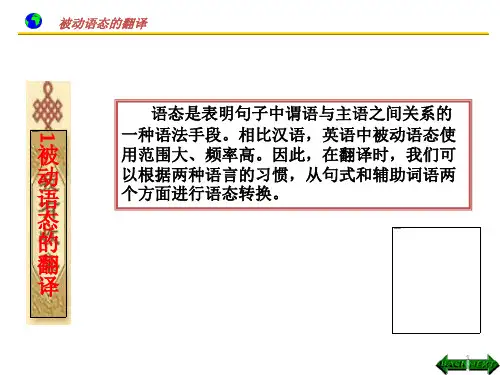


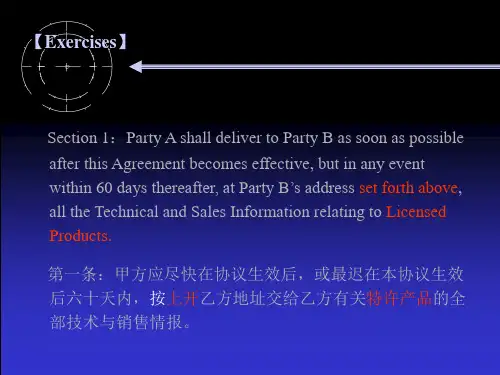
![商务英语翻译8.2 被动语态的翻译[精]](https://uimg.taocdn.com/a1e43f8a5ef7ba0d4a733bd8.webp)

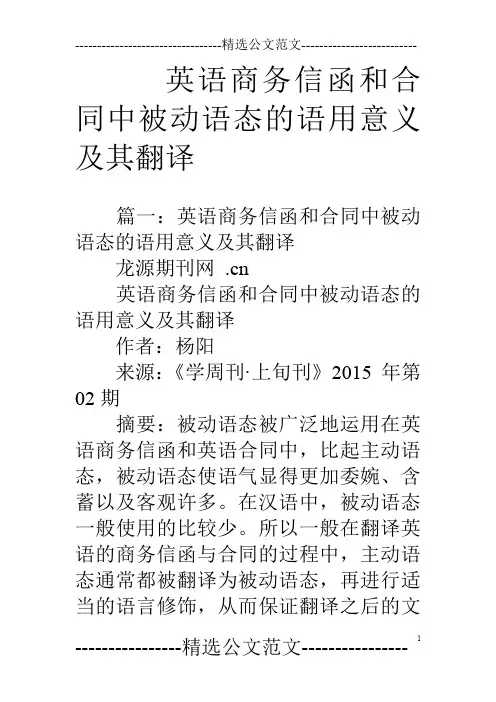
英语商务信函和合同中被动语态的语用意义及其翻译篇一:英语商务信函和合同中被动语态的语用意义及其翻译龙源期刊网.cn英语商务信函和合同中被动语态的语用意义及其翻译作者:杨阳来源:《学周刊·上旬刊》2015年第02期摘要:被动语态被广泛地运用在英语商务信函和英语合同中,比起主动语态,被动语态使语气显得更加委婉、含蓄以及客观许多。
在汉语中,被动语态一般使用的比较少。
所以一般在翻译英语的商务信函与合同的过程中,主动语态通常都被翻译为被动语态,再进行适当的语言修饰,从而保证翻译之后的文章流畅通顺。
关键词:英语商务信函被动语态作为商务英语中比较常见的一种语法现象,有助于体现合作的礼貌与原则。
而商务英语中,被动语态的使用和汉语的被动语态的用法有着一定程度上的不同。
本文主要就针对商务英语中被动语态使用较多的商务信函与合同进行分析,从而更好地理解被动语态在商务英语中的应用与翻译状况。
一、对被动语态的认识被动语态作为动词的一种形式存在,主要是指主语是谓语动作的承受者。
若是要讲述一个客观事实就需要借助被动语态。
被动语态强调的是动作的承受者,而不是动作的发出者。
被动语态通常都是由by引导出来的,但是也有由介词by引导出来的短语,如“by bike”(骑自行车)“by bus”(坐公共汽车)等。
并且还有一些真被动、假主动的十几个常用词的用法都需要我们注意,如“so heavy to carry”表示的就是被动语态,但却不是用的“so heavy to be carried”。
针对被动语态使用的不同情况,我们一定要做到全面掌握每一种被动语态,这对于学习英语及商务信函和合同的翻译都是十分重要的。
二、英语商务信函和合同中被动语态的语用意义及其翻译(一)英语商务信函中被动语态的语用意义及其翻译被动语态作为一种重要的语言手段与工具被广泛运用在商务英语中。
与主动语态相比,被动语态不强调动作的发出者,这样在语气上就会显得委婉许多,也不会让动作的承受者感受到一种发出者将某种意思强加的强硬感觉。
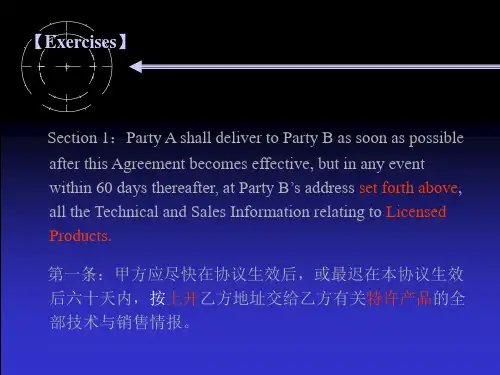
商务英语2课文及翻译Unit 7索赔与付款是货物贸易中常见的现象。
有理有据地提出诉求远比胡搅蛮缠或漫天要价令人信服。
付款的方式有很多种,同样,与客户的有效沟通,方能达成一致,互利共赢。
1.Business Complaint投诉Daniel gets a call from a customer, Mr. Wilson, who is complaining about an error in the weight of his delivery.客户威尔逊打电话给丹尼尔,投诉交货重量的误差问题。
D: Hello, Mr. Wilson. Your request for compensation surprises me. What happened?丹尼尔:您好,威尔逊先生。
您对于索赔的请求让我很吃惊。
发生了什么事?W: The issue is a shortage of weight. The Tianjin Commodity Inspection Bureau's report shows a difference of 15 tons between the actual landed weight and the invoiced weight.威尔逊:是货物重量不足的问题。
天津商品检验局的报告显示发票标示的重量与实际落地的重量相差了15吨。
D: We regret we cannot review your claim as it really has nothing to do with us.I would like to point out that the weight of the cargo on loading was taken by actual physical weighing of the product. The scales were checked and the captain of the ship supervised the weighing, so he can prove that full weight was delivered.丹尼尔:很遗憾,我们不能处理您的索赔,因为这和我们没有任何关系。
第七单元服务行业TEXT A 服务行业与服务管理我们现在正处于一个服务的时代,并且服务已经逐渐处于社会的中心地位。
在美国,各种各样的服务占据了美国就业市场的80%,服务行业已经创造了GNP的74%,占经济活动的55%,这些都远远把制造业抛在了后面。
其它发达国家也在过去的20年内同样也经历了这样一个趋势。
因此我们必须首先弄懂,“什么叫服务?〞我们通常把服务叫做由个人或团体为获益他人而做的工作。
我们的经济结构和贸易理念一起在改变,而这种改变最终导致由产品为中心转移到以服务为中心,被称为“第二次革命〞和“信息社会的开端〞。
那什么叫服务行业呢?当政府官员或经济学家提到服务行业,他们总会定义其为“创造不可见产品的行业。
〞服务行业分为以下几个部分。
运输服务、邮递服务和仓储服务信息服务股票证券服务和其它金融投资服务租赁服务职业、科技服务行政服务、废物回收服务和维修服务健康保健服务与社会援助服务艺术、娱乐、休闲服务其它服务从上面的分类我们可以看出,现今服务已经渗透到我们生活的各个角落。
不言而喻服务在我们的日常生活与商务活动中扮演越来越重要的角色。
然而并不是所有人与公司或组织会意识到服务的重要性。
许多经理像鸵鸟一样只是把它们的头深埋在沙子里,许多人袖着手违心地说,“服务大潮只不过像一阵风罢了,不是吗?〞当然,从另一方面,也有许多工作人善于服务,请看下面的案例。
Stew Leonard 经营着一家利润丰厚的三层楼的商店。
他说每当他看到一个愠怒的顾客就如同看到5万美元飞出了他的商店。
为什么呢?因为,像这种一般的顾客每个星期花100美元,一年有50周要购物,然后呆在这个地方可能大约10年。
如果这样的一个顾客在商店有一次不愉快的经历而反而转身另外一家商店的话,那Stew Leonard商店就会少5万美元的收入。
如果这个不满意的顾客把他的不愉快的经历告诉其他顾客,让他们也离开的话,那损失将会更大。
为了挽回顾客,Stew Leonard商店创造了被《纽约时报》称为“商店中的迪斯尼乐园〞,设有化妆的卡通人物、定期的娱乐项目、宠物乐园与电子动物。